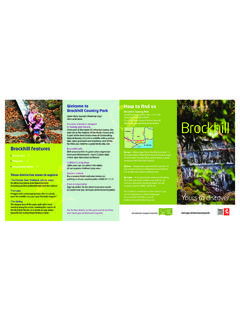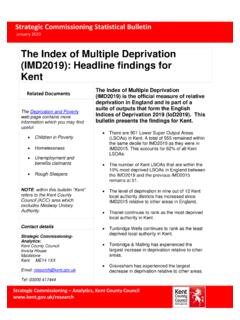Transcription of Road Pavement Design Guide - Kent County Council
1 road Pavement Design \HMRB CD Version 2\October 2001\Page 1 of 54 Copyright KCC road Pavement Design Guide July 2000 Kent County Council : road Pavement Design Guide road Pavement Design \HMRB CD Version 2\October 2001\Page 1 of 54 Copyright KCC CONTENTS 1 Introduction 3 2 Use of the Design Guide and Pavement Options 4 3 Measurement of Subgrade 6 Site Investigation 6 Selection of method for determination of CBR. 7 4 Design of Foundation Layer 9 Role of Foundation Layer 9 Drainage 9 Foundation Material Selection 10 Design of foundation layer thickness 11 Foundation during construction 11 Design for Equilibrium foundation stiffness. 12 Frost Protection 13 Alternative materials for Category A material as sub-base 14 Less Stiff Materials 14 More stiff materials 14 Alternative Materials for capping layer and sub-base 15 Recycled aggregates and secondary materials 15 Categories of Alternative Granular Materials 15 Approval of Alternative granular materials 17 5 Traffic 18 General 18 Numbers of Commercial vehicles 18 Commercial Vehicles Classification and numbers per day 18 Computation of total traffic using a detailed traffic count 19 Vehicle Wear Factor 19 Design Life 20 Growth Factor 21 Left hand lane factor 22 Channelisation 22 Calculation of Cumulative Design Traffic 22 Computation of total traffic using
2 A Classified goods vehicle count or estimate 22 estimation of total traffic using NRSWA road Type 23 Traffic from the Kent Design Guide Description 24 6 Structural Layer Design 25 Flexible Construction 25 Selection of Grade of material 27 Kent County Council : road Pavement Design Guide road Pavement Design \HMRB CD Version 2\October 2001\Page 2 of 54 Copyright KCC Layer thickness 27 Cement Bound Roadbase 28 Asphalt overlay to Cement Bound Roadbase 28 Hydraulic Bound Roadbase 29 Asphalt overlay to Hydraulic Bound Material 29 7 Surfacing Design 30 Materials Selection 30 Skid resistance 31 High Friction Surfacing (HFS) 31 Colour 31 8 Block Pavement Design 33 Slip/Skid Resistance 33 Abrasion Resistance 33 Colour 33 Chamfers 34 9 Alternative Designs for maintenance 35 10 Construction Issues 36 11 Overlays and bridges.
3 36 12 Further Information 37 APPENDIX A Design Traffic Chart for 20 year life (DMRB HD24/96 ) Derivation of Growth Factor Worked example of cumulative traffic calculation APPENDIX B 1 Design Chart for Flexible Construction (DBM50) 2 Design Chart for Flexible Construction (All common Roadbase materials) 3 Equivalence Factor adjustment for roadbase stiffness 4 Design Chart for Composite Construction with Cement and Hydraulic Binders 5 Pavement Design for roads surfaced with pavers 6 Construction thickness for pavers and flags in lightly trafficked applications APPENDIX C PSV Requirements for Site Classification and Traffic APPENDIX D Equivalence Factors for Design and maintenance APPENDIX E Worked example for equivalence factors in maintenance APPENDIX F Preferred Methods of Determining Subgrade CBR including references Kent County Council .
4 road Pavement Design Guide road Pavement Design \HMRB CD Version 2\October 2001\Page 3 of 54 Copyright KCC 1 Introduction In 1984 TRRL published Report LR1132, The Structural Design of Bituminous Roads Powell, Potter Mayhew and Nunn . This research document was translated for use by highways Design engineers working in Kent and published first as M85/2 in 1985. This document was replaced in 1988 by M88/1. It enlarged upon some aspects of the DTp Design Guide and related it to reconstruction/rehabilitation works. Over the years changes have occurred, principally in the measurement of sub-grade strength, changes in advice from Central Government (Highways Agency [HA]) in their Design manual for road and Bridge Works [DMRB], the introduction of new materials for the structural layer, the demise of Hot Rolled Asphalt as a surfacing material and the need to promote sustainable construction techniques, in particular recycling.
5 It has been found necessary to revise M88/1 and the similar Report 013 with this document (M99). In addition the subgrade assessment philosophy contained within M88/2 has been incorporated within this document for the sake of convenience The major changes between this document and M88/1 and Report 013 are as follows: Subgrade at time of construction and during the life of the Pavement [equilibrium] has to be evaluated Traffic levels can be determined in a number of ways Whilst designs are based on Type 1 sub-base (Category A material), alternatives have been provided for Contractors to propose in order to encourage the use of secondary aggregates Asphalt substitution has been extended to cover other materials and designs for in-situ recycling /stabilisation are included.
6 The use of hydraulic bound bases has been enlarged Hot rolled asphalt roadbase has been discontinued. Whilst a Design based on DBM50 is the norm, information has been provided so Contractors can offer other thickness of other asphalt materials. (Note: The term asphalt is now used for all bitumen bound materials) Hot Rolled Asphalt wearing course has been substituted with Thin Surfacing Concrete Block paving Design is included within British Standards, but the key tables are included. For the new construction of heavily trafficked roads and motorways the Design Guide is identical to that published by HA. For other sites it compiles the best current practice. There are projects on-going to improve the Design of lightly trafficked pavements and these will be incorporated, as they become available.
7 Kent County Council publishes a number of reports, specification clauses and notes for guidance these are referred to but not included herein. This document contains guidance on the evaluation of foundation strength, determination of materials and layer thickness for new works and reconstruction of existing carriageways. The information provided is to be included in Appendix 7/1 of the Contract as applicable. Contractors may provide alternative materials and construction thickness, with the approval of the engineer, but such alternatives should deliver equivalent performance to those described in this document. Kent County Council : road Pavement Design Guide road Pavement Design \HMRB CD Version 2\October 2001\Page 4 of 54 Copyright KCC 2 Use of the Design Guide and Pavement Options This document is intended to cover the Design of new schemes of any size and reconstruction or rehabilitation on existing highways.
8 However a Design carried out in accordance with this Guide has no definable maintenance free life as this is significantly affected by the quality of installation/ construction. However an implied structural Design life of 20 years has been assumed as the norm. The key information is given in tables in bold type or with text surrounded thus. Other information is explanatory or for information only It is intended that the scheme designer should carry out a Pavement Design based on one foundation Design ;( sub-base alone or sub-base plus capping layer), and one flexible Design for the structural layer (unless a concrete block surface is preferred). The designer may select a different sub-base or structural layer option stabilised material or a hydraulic bound roadbase, and Design information has been provided.
9 It is expected that a contractor may put forward alternative designs using materials of equivalent performance recycled materials/techniques as permitted by this document in order to reduce costs. In order to do this the designer will need to put on the drawings or elsewhere in the contract documents the equilibrium CBR and Design traffic so that the necessary calculations can be carried out. Whilst the Highways Agency expects that the contractor to be given a free choice of Pavement construction options between flexible, flexible/composite and rigid Pavement for their schemes, in Kent the use of the rigid options is not permitted for a highway. Design guidance for Rigid Pavements is not included. In other situations where this form of construction may be advantageous hardstandings or other pavements receiving heavy loading from, for example, fork lift trucks, designers should consult the relevant section in the Design manual for road and Bridges or other Pavement Design guidance.
10 Concrete block surfaces are suitable for these applications. Hydraulic bound binders are preferred for the flexible composite option in order to reduce the possible maintenance requirements caused by reflective cracking. Portland cement binders are only permitted in the following circumstances: a) in-situ recycling with cement is to be used, this is in order to promote recycling as a policy. b) the surfacing layer is to be concrete or clay pavers, setts or flags/slabs. c) traffic requirements mean that more than 180 mm of asphalt overlay is required a Total Design flow in excess of 20msa. A Pavement construction may need to satisfy 4 structural functions: a) to provide a construction access route for building the works if necessary. b) to provide a layer of sufficient stiffness so that subsequent layers can be compacted properly.










